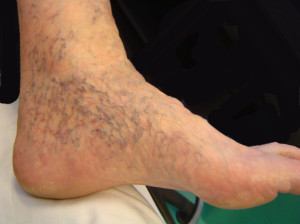This is short for corona phlebectatica paraplantaris and was first recognised by van der Molen in 1960. Unrelenting venous pressure over time will cause susceptible cutaneous venules to dilate. This is most likely to occur around the ankle which is the region of the highest hydrostatic pressure. This is below a failing calf muscle pump but above an active foot muscle pump. Cutaneous changes may also reflect deeper changes in the gaiter area. The significance of these telangiectasiae are controversial. They remain classified in clinical CEAP as C1. However, it is clear that the occasional thigh telangiectasia is less significant than the venous flare or collection of dilated venules or blue blebs at the instep of the foot. Therefore, their site should determine their importance in staging the severity of venous disease. This observation remains one of the most controversial areas in venous disease and is the driving force behind elevating the ankle corona to the clinical CEAP stage of C3.
JEAN-FRANCOIS UHL Corona phlebectatica (corona) is a clinical sign of chronic venous disease (CVD). It is defined by the presence of blue telangiectasiae and stasis spots. Blue telangiectasiae are the most sensitive sign, but stasis spots have the greatest specificity. Their co-existence is a good operational criterion for the positive diagnosis of a corona. A corona has been shown to have a significant correlation with the presence of incompetent perforating veins of the leg. Furthermore, its presence has a high predictive value for the development of skin changes and venous ulceration in the next few years, as part of the progression of venous disease. For this reason, a corona should no longer be considered as simple telangiectasiae of the foot (C1). It is a simple and reliable clinical entity which is easy to diagnose. As it is extremely relevant as a marker of CVD severity it should be classified as C3. Therefore, a careful examination of the ankle should be performed in all patients presenting with CVD to determine the presence or absence of a corona.
